Artic PLC Financial Report: Analysis, Recommendations, and Investment
VerifiedAdded on 2022/11/26
|27
|5619
|207
Report
AI Summary
This report provides a comprehensive financial analysis of Artic PLC, a company manufacturing electronic components. The analysis encompasses five key financial areas: profitability, liquidity, efficiency, investment, and gearing, using ratio analysis to assess performance over four years and compare it to competitors and industry norms. The report evaluates the company's strengths and weaknesses, offering recommendations for improvement in each area. Furthermore, it explores capital project appraisal models, including NPV, IRR, and payback period, to assess potential investment opportunities. The report critically evaluates each model and applies them to specific investment scenarios, considering factors like divisibility and optimal investment policies. It also addresses difficulties in appraising capital investments and suggests ways to overcome them, providing a complete financial overview and strategic guidance for Artic PLC's future.
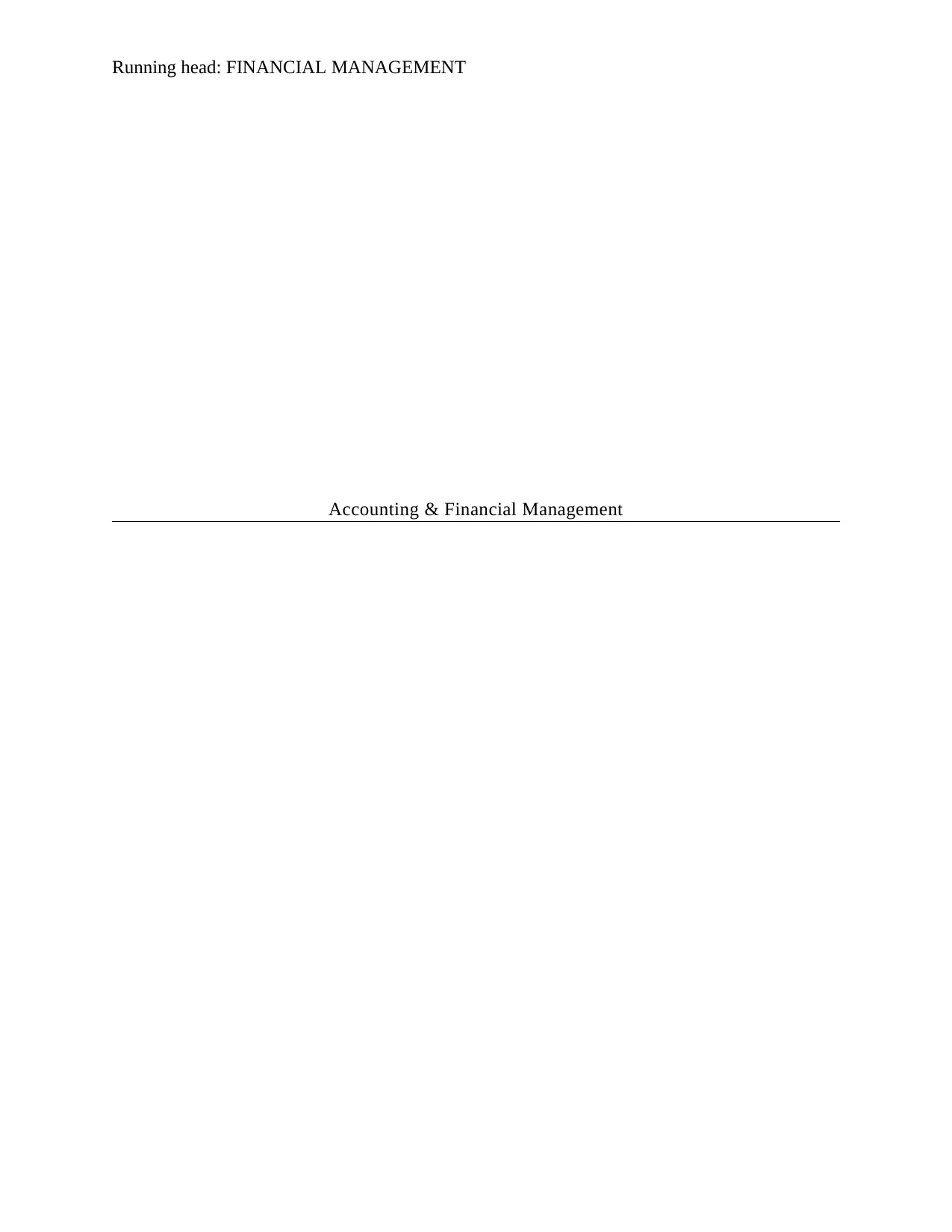
Running head: FINANCIAL MANAGEMENT
Accounting & Financial Management
Accounting & Financial Management
Paraphrase This Document
Need a fresh take? Get an instant paraphrase of this document with our AI Paraphraser
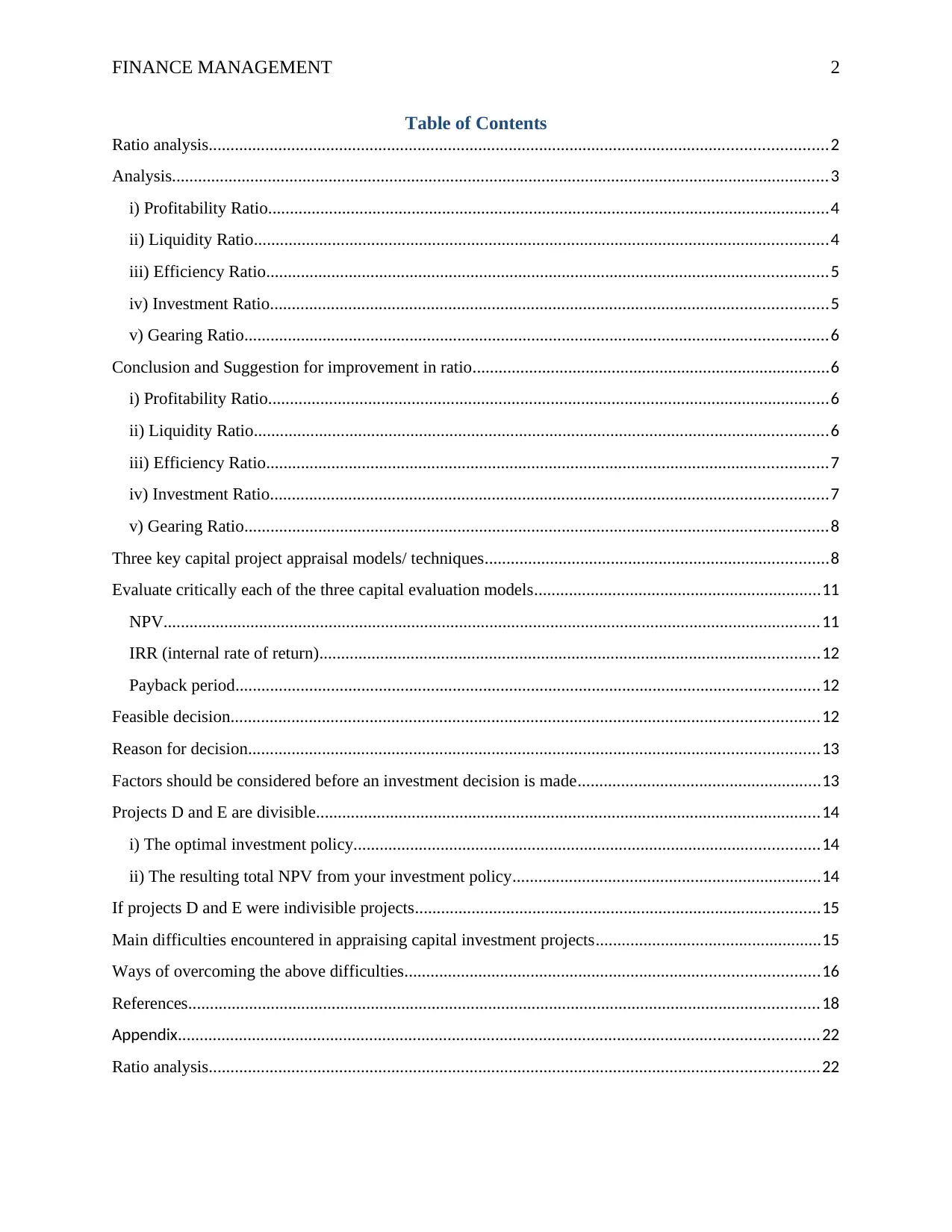
FINANCE MANAGEMENT 2
Table of Contents
Ratio analysis..............................................................................................................................................2
Analysis.......................................................................................................................................................3
i) Profitability Ratio.................................................................................................................................4
ii) Liquidity Ratio....................................................................................................................................4
iii) Efficiency Ratio.................................................................................................................................5
iv) Investment Ratio................................................................................................................................5
v) Gearing Ratio......................................................................................................................................6
Conclusion and Suggestion for improvement in ratio..................................................................................6
i) Profitability Ratio.................................................................................................................................6
ii) Liquidity Ratio....................................................................................................................................6
iii) Efficiency Ratio.................................................................................................................................7
iv) Investment Ratio................................................................................................................................7
v) Gearing Ratio......................................................................................................................................8
Three key capital project appraisal models/ techniques...............................................................................8
Evaluate critically each of the three capital evaluation models..................................................................11
NPV.......................................................................................................................................................11
IRR (internal rate of return)...................................................................................................................12
Payback period......................................................................................................................................12
Feasible decision.......................................................................................................................................12
Reason for decision...................................................................................................................................13
Factors should be considered before an investment decision is made........................................................13
Projects D and E are divisible....................................................................................................................14
i) The optimal investment policy...........................................................................................................14
ii) The resulting total NPV from your investment policy.......................................................................14
If projects D and E were indivisible projects.............................................................................................15
Main difficulties encountered in appraising capital investment projects....................................................15
Ways of overcoming the above difficulties...............................................................................................16
References.................................................................................................................................................18
Appendix...................................................................................................................................................22
Ratio analysis............................................................................................................................................22
Table of Contents
Ratio analysis..............................................................................................................................................2
Analysis.......................................................................................................................................................3
i) Profitability Ratio.................................................................................................................................4
ii) Liquidity Ratio....................................................................................................................................4
iii) Efficiency Ratio.................................................................................................................................5
iv) Investment Ratio................................................................................................................................5
v) Gearing Ratio......................................................................................................................................6
Conclusion and Suggestion for improvement in ratio..................................................................................6
i) Profitability Ratio.................................................................................................................................6
ii) Liquidity Ratio....................................................................................................................................6
iii) Efficiency Ratio.................................................................................................................................7
iv) Investment Ratio................................................................................................................................7
v) Gearing Ratio......................................................................................................................................8
Three key capital project appraisal models/ techniques...............................................................................8
Evaluate critically each of the three capital evaluation models..................................................................11
NPV.......................................................................................................................................................11
IRR (internal rate of return)...................................................................................................................12
Payback period......................................................................................................................................12
Feasible decision.......................................................................................................................................12
Reason for decision...................................................................................................................................13
Factors should be considered before an investment decision is made........................................................13
Projects D and E are divisible....................................................................................................................14
i) The optimal investment policy...........................................................................................................14
ii) The resulting total NPV from your investment policy.......................................................................14
If projects D and E were indivisible projects.............................................................................................15
Main difficulties encountered in appraising capital investment projects....................................................15
Ways of overcoming the above difficulties...............................................................................................16
References.................................................................................................................................................18
Appendix...................................................................................................................................................22
Ratio analysis............................................................................................................................................22
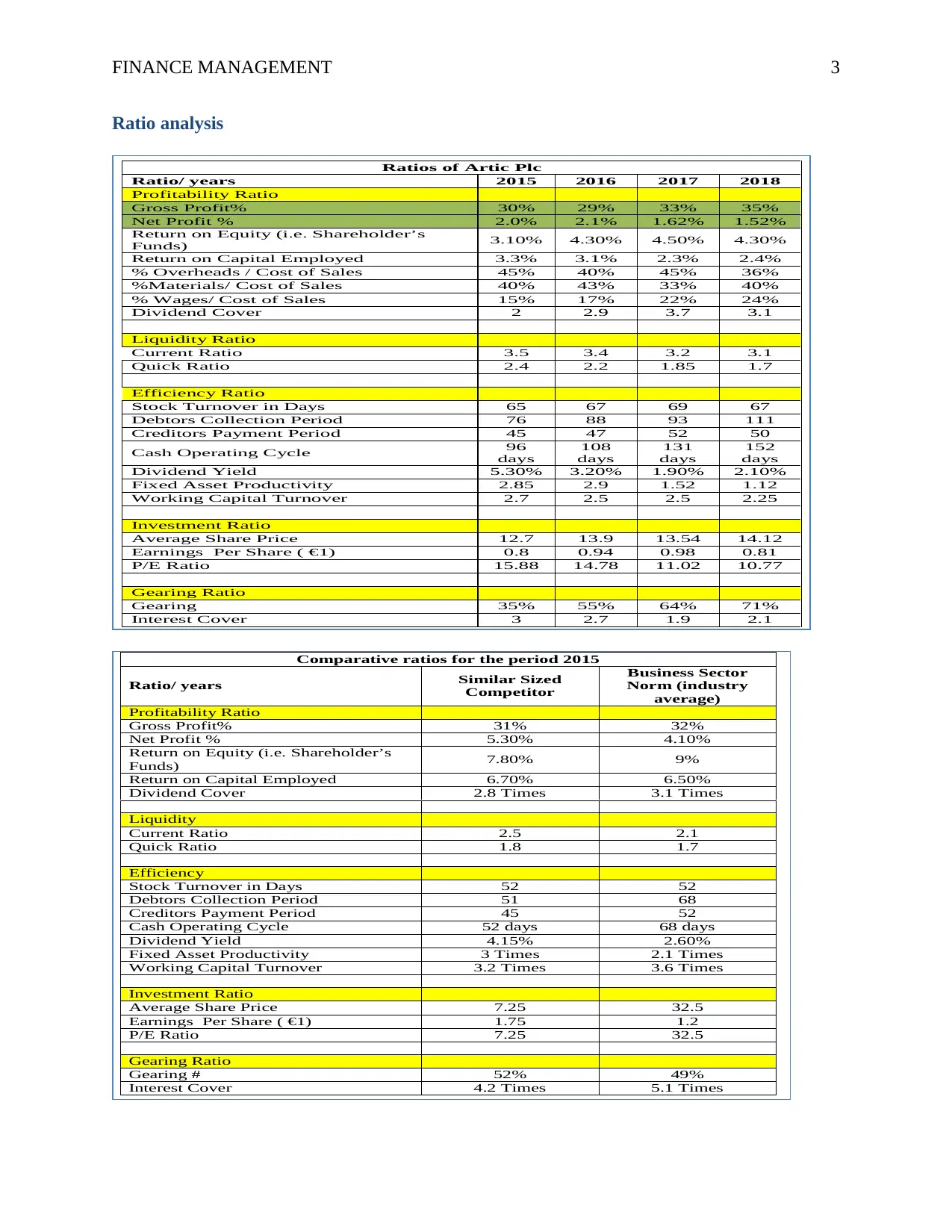
FINANCE MANAGEMENT 3
Ratio analysis
Ratios of Artic Plc
Ratio/ years 2015 2016 2017 2018
Profitability Ratio
Gross Profit% 30% 29% 33% 35%
Net Profit % 2.0% 2.1% 1.62% 1.52%
Return on Equity (i.e. Shareholder’s
Funds) 3.10% 4.30% 4.50% 4.30%
Return on Capital Employed 3.3% 3.1% 2.3% 2.4%
% Overheads / Cost of Sales 45% 40% 45% 36%
%Materials/ Cost of Sales 40% 43% 33% 40%
% Wages/ Cost of Sales 15% 17% 22% 24%
Dividend Cover 2 2.9 3.7 3.1
Liquidity Ratio
Current Ratio 3.5 3.4 3.2 3.1
Quick Ratio 2.4 2.2 1.85 1.7
Efficiency Ratio
Stock Turnover in Days 65 67 69 67
Debtors Collection Period 76 88 93 111
Creditors Payment Period 45 47 52 50
Cash Operating Cycle 96
days
108
days
131
days
152
days
Dividend Yield 5.30% 3.20% 1.90% 2.10%
Fixed Asset Productivity 2.85 2.9 1.52 1.12
Working Capital Turnover 2.7 2.5 2.5 2.25
Investment Ratio
Average Share Price 12.7 13.9 13.54 14.12
Earnings Per Share ( €1) 0.8 0.94 0.98 0.81
P/E Ratio 15.88 14.78 11.02 10.77
Gearing Ratio
Gearing 35% 55% 64% 71%
Interest Cover 3 2.7 1.9 2.1
Comparative ratios for the period 2015
Ratio/ years Similar Sized
Competitor
Business Sector
Norm (industry
average)
Profitability Ratio
Gross Profit% 31% 32%
Net Profit % 5.30% 4.10%
Return on Equity (i.e. Shareholder’s
Funds) 7.80% 9%
Return on Capital Employed 6.70% 6.50%
Dividend Cover 2.8 Times 3.1 Times
Liquidity
Current Ratio 2.5 2.1
Quick Ratio 1.8 1.7
Efficiency
Stock Turnover in Days 52 52
Debtors Collection Period 51 68
Creditors Payment Period 45 52
Cash Operating Cycle 52 days 68 days
Dividend Yield 4.15% 2.60%
Fixed Asset Productivity 3 Times 2.1 Times
Working Capital Turnover 3.2 Times 3.6 Times
Investment Ratio
Average Share Price 7.25 32.5
Earnings Per Share ( €1) 1.75 1.2
P/E Ratio 7.25 32.5
Gearing Ratio
Gearing # 52% 49%
Interest Cover 4.2 Times 5.1 Times
Ratio analysis
Ratios of Artic Plc
Ratio/ years 2015 2016 2017 2018
Profitability Ratio
Gross Profit% 30% 29% 33% 35%
Net Profit % 2.0% 2.1% 1.62% 1.52%
Return on Equity (i.e. Shareholder’s
Funds) 3.10% 4.30% 4.50% 4.30%
Return on Capital Employed 3.3% 3.1% 2.3% 2.4%
% Overheads / Cost of Sales 45% 40% 45% 36%
%Materials/ Cost of Sales 40% 43% 33% 40%
% Wages/ Cost of Sales 15% 17% 22% 24%
Dividend Cover 2 2.9 3.7 3.1
Liquidity Ratio
Current Ratio 3.5 3.4 3.2 3.1
Quick Ratio 2.4 2.2 1.85 1.7
Efficiency Ratio
Stock Turnover in Days 65 67 69 67
Debtors Collection Period 76 88 93 111
Creditors Payment Period 45 47 52 50
Cash Operating Cycle 96
days
108
days
131
days
152
days
Dividend Yield 5.30% 3.20% 1.90% 2.10%
Fixed Asset Productivity 2.85 2.9 1.52 1.12
Working Capital Turnover 2.7 2.5 2.5 2.25
Investment Ratio
Average Share Price 12.7 13.9 13.54 14.12
Earnings Per Share ( €1) 0.8 0.94 0.98 0.81
P/E Ratio 15.88 14.78 11.02 10.77
Gearing Ratio
Gearing 35% 55% 64% 71%
Interest Cover 3 2.7 1.9 2.1
Comparative ratios for the period 2015
Ratio/ years Similar Sized
Competitor
Business Sector
Norm (industry
average)
Profitability Ratio
Gross Profit% 31% 32%
Net Profit % 5.30% 4.10%
Return on Equity (i.e. Shareholder’s
Funds) 7.80% 9%
Return on Capital Employed 6.70% 6.50%
Dividend Cover 2.8 Times 3.1 Times
Liquidity
Current Ratio 2.5 2.1
Quick Ratio 1.8 1.7
Efficiency
Stock Turnover in Days 52 52
Debtors Collection Period 51 68
Creditors Payment Period 45 52
Cash Operating Cycle 52 days 68 days
Dividend Yield 4.15% 2.60%
Fixed Asset Productivity 3 Times 2.1 Times
Working Capital Turnover 3.2 Times 3.6 Times
Investment Ratio
Average Share Price 7.25 32.5
Earnings Per Share ( €1) 1.75 1.2
P/E Ratio 7.25 32.5
Gearing Ratio
Gearing # 52% 49%
Interest Cover 4.2 Times 5.1 Times
⊘ This is a preview!⊘
Do you want full access?
Subscribe today to unlock all pages.

Trusted by 1+ million students worldwide
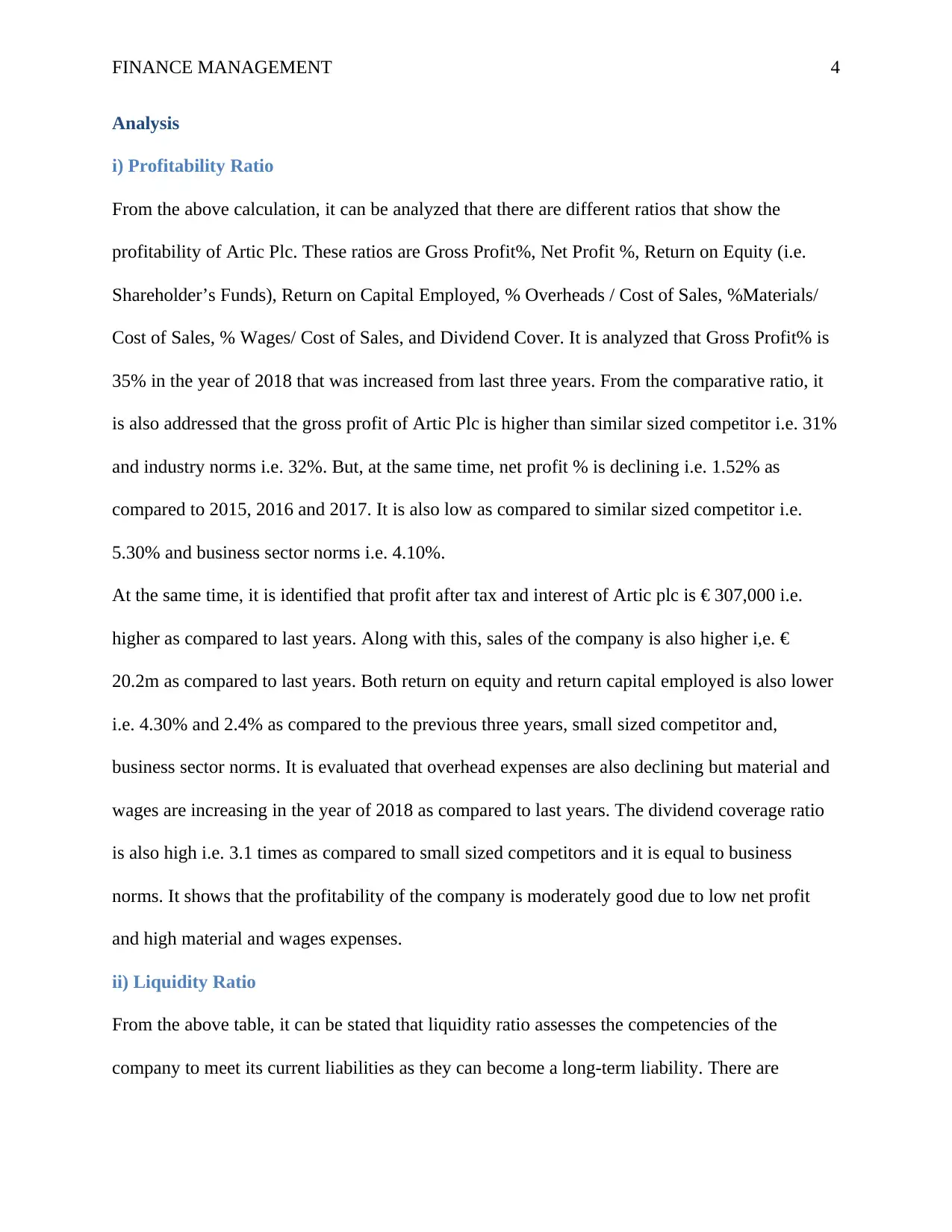
FINANCE MANAGEMENT 4
Analysis
i) Profitability Ratio
From the above calculation, it can be analyzed that there are different ratios that show the
profitability of Artic Plc. These ratios are Gross Profit%, Net Profit %, Return on Equity (i.e.
Shareholder’s Funds), Return on Capital Employed, % Overheads / Cost of Sales, %Materials/
Cost of Sales, % Wages/ Cost of Sales, and Dividend Cover. It is analyzed that Gross Profit% is
35% in the year of 2018 that was increased from last three years. From the comparative ratio, it
is also addressed that the gross profit of Artic Plc is higher than similar sized competitor i.e. 31%
and industry norms i.e. 32%. But, at the same time, net profit % is declining i.e. 1.52% as
compared to 2015, 2016 and 2017. It is also low as compared to similar sized competitor i.e.
5.30% and business sector norms i.e. 4.10%.
At the same time, it is identified that profit after tax and interest of Artic plc is € 307,000 i.e.
higher as compared to last years. Along with this, sales of the company is also higher i,e. €
20.2m as compared to last years. Both return on equity and return capital employed is also lower
i.e. 4.30% and 2.4% as compared to the previous three years, small sized competitor and,
business sector norms. It is evaluated that overhead expenses are also declining but material and
wages are increasing in the year of 2018 as compared to last years. The dividend coverage ratio
is also high i.e. 3.1 times as compared to small sized competitors and it is equal to business
norms. It shows that the profitability of the company is moderately good due to low net profit
and high material and wages expenses.
ii) Liquidity Ratio
From the above table, it can be stated that liquidity ratio assesses the competencies of the
company to meet its current liabilities as they can become a long-term liability. There are
Analysis
i) Profitability Ratio
From the above calculation, it can be analyzed that there are different ratios that show the
profitability of Artic Plc. These ratios are Gross Profit%, Net Profit %, Return on Equity (i.e.
Shareholder’s Funds), Return on Capital Employed, % Overheads / Cost of Sales, %Materials/
Cost of Sales, % Wages/ Cost of Sales, and Dividend Cover. It is analyzed that Gross Profit% is
35% in the year of 2018 that was increased from last three years. From the comparative ratio, it
is also addressed that the gross profit of Artic Plc is higher than similar sized competitor i.e. 31%
and industry norms i.e. 32%. But, at the same time, net profit % is declining i.e. 1.52% as
compared to 2015, 2016 and 2017. It is also low as compared to similar sized competitor i.e.
5.30% and business sector norms i.e. 4.10%.
At the same time, it is identified that profit after tax and interest of Artic plc is € 307,000 i.e.
higher as compared to last years. Along with this, sales of the company is also higher i,e. €
20.2m as compared to last years. Both return on equity and return capital employed is also lower
i.e. 4.30% and 2.4% as compared to the previous three years, small sized competitor and,
business sector norms. It is evaluated that overhead expenses are also declining but material and
wages are increasing in the year of 2018 as compared to last years. The dividend coverage ratio
is also high i.e. 3.1 times as compared to small sized competitors and it is equal to business
norms. It shows that the profitability of the company is moderately good due to low net profit
and high material and wages expenses.
ii) Liquidity Ratio
From the above table, it can be stated that liquidity ratio assesses the competencies of the
company to meet its current liabilities as they can become a long-term liability. There are
Paraphrase This Document
Need a fresh take? Get an instant paraphrase of this document with our AI Paraphraser
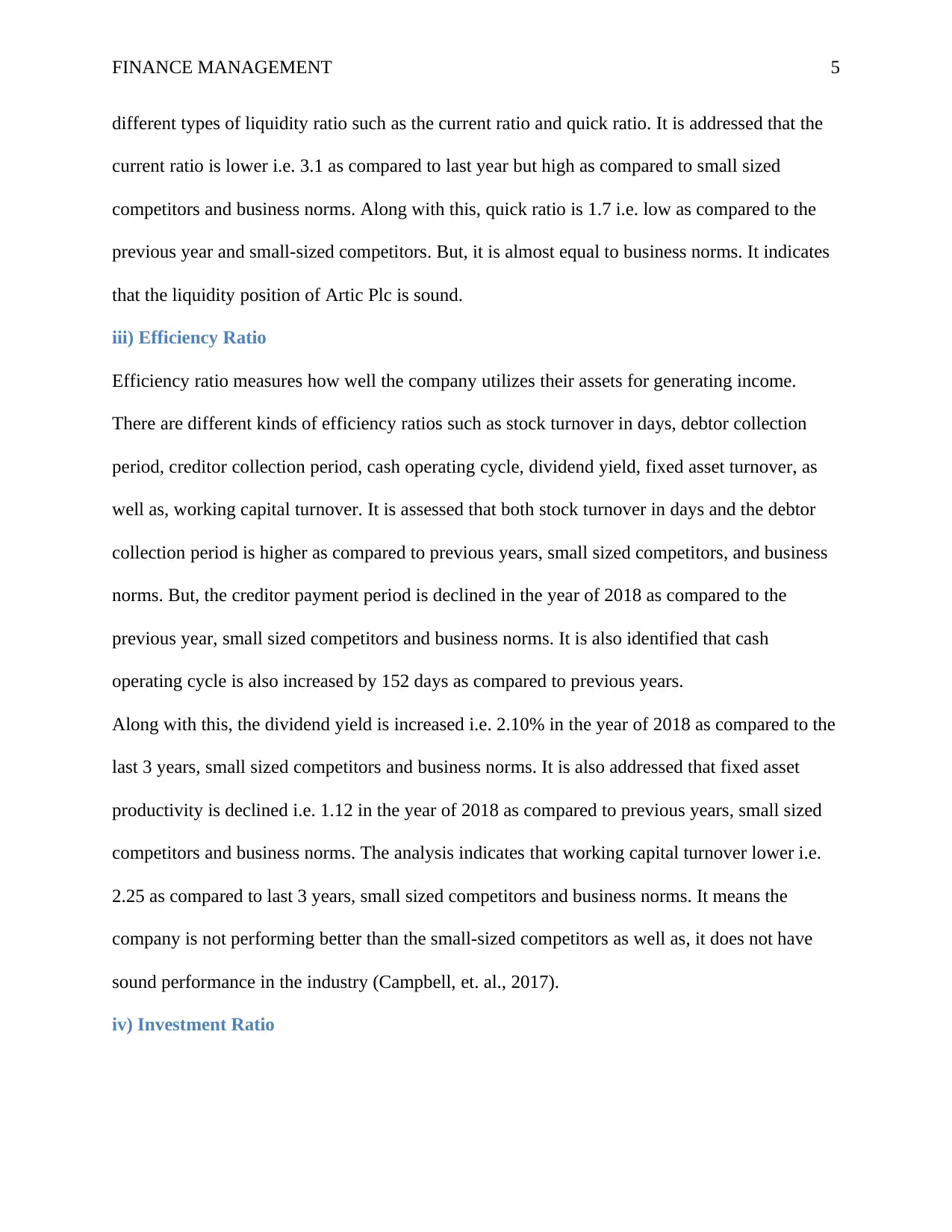
FINANCE MANAGEMENT 5
different types of liquidity ratio such as the current ratio and quick ratio. It is addressed that the
current ratio is lower i.e. 3.1 as compared to last year but high as compared to small sized
competitors and business norms. Along with this, quick ratio is 1.7 i.e. low as compared to the
previous year and small-sized competitors. But, it is almost equal to business norms. It indicates
that the liquidity position of Artic Plc is sound.
iii) Efficiency Ratio
Efficiency ratio measures how well the company utilizes their assets for generating income.
There are different kinds of efficiency ratios such as stock turnover in days, debtor collection
period, creditor collection period, cash operating cycle, dividend yield, fixed asset turnover, as
well as, working capital turnover. It is assessed that both stock turnover in days and the debtor
collection period is higher as compared to previous years, small sized competitors, and business
norms. But, the creditor payment period is declined in the year of 2018 as compared to the
previous year, small sized competitors and business norms. It is also identified that cash
operating cycle is also increased by 152 days as compared to previous years.
Along with this, the dividend yield is increased i.e. 2.10% in the year of 2018 as compared to the
last 3 years, small sized competitors and business norms. It is also addressed that fixed asset
productivity is declined i.e. 1.12 in the year of 2018 as compared to previous years, small sized
competitors and business norms. The analysis indicates that working capital turnover lower i.e.
2.25 as compared to last 3 years, small sized competitors and business norms. It means the
company is not performing better than the small-sized competitors as well as, it does not have
sound performance in the industry (Campbell, et. al., 2017).
iv) Investment Ratio
different types of liquidity ratio such as the current ratio and quick ratio. It is addressed that the
current ratio is lower i.e. 3.1 as compared to last year but high as compared to small sized
competitors and business norms. Along with this, quick ratio is 1.7 i.e. low as compared to the
previous year and small-sized competitors. But, it is almost equal to business norms. It indicates
that the liquidity position of Artic Plc is sound.
iii) Efficiency Ratio
Efficiency ratio measures how well the company utilizes their assets for generating income.
There are different kinds of efficiency ratios such as stock turnover in days, debtor collection
period, creditor collection period, cash operating cycle, dividend yield, fixed asset turnover, as
well as, working capital turnover. It is assessed that both stock turnover in days and the debtor
collection period is higher as compared to previous years, small sized competitors, and business
norms. But, the creditor payment period is declined in the year of 2018 as compared to the
previous year, small sized competitors and business norms. It is also identified that cash
operating cycle is also increased by 152 days as compared to previous years.
Along with this, the dividend yield is increased i.e. 2.10% in the year of 2018 as compared to the
last 3 years, small sized competitors and business norms. It is also addressed that fixed asset
productivity is declined i.e. 1.12 in the year of 2018 as compared to previous years, small sized
competitors and business norms. The analysis indicates that working capital turnover lower i.e.
2.25 as compared to last 3 years, small sized competitors and business norms. It means the
company is not performing better than the small-sized competitors as well as, it does not have
sound performance in the industry (Campbell, et. al., 2017).
iv) Investment Ratio
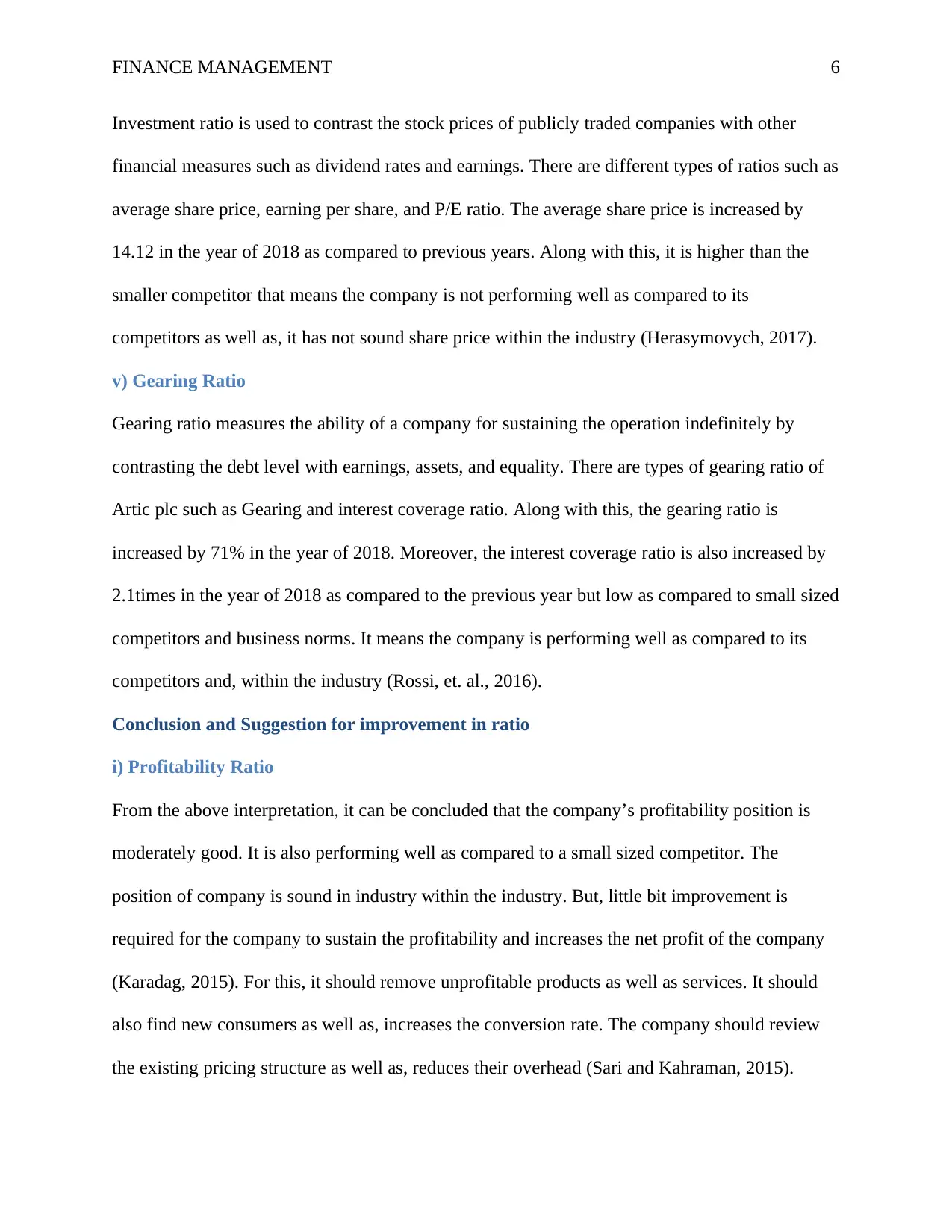
FINANCE MANAGEMENT 6
Investment ratio is used to contrast the stock prices of publicly traded companies with other
financial measures such as dividend rates and earnings. There are different types of ratios such as
average share price, earning per share, and P/E ratio. The average share price is increased by
14.12 in the year of 2018 as compared to previous years. Along with this, it is higher than the
smaller competitor that means the company is not performing well as compared to its
competitors as well as, it has not sound share price within the industry (Herasymovych, 2017).
v) Gearing Ratio
Gearing ratio measures the ability of a company for sustaining the operation indefinitely by
contrasting the debt level with earnings, assets, and equality. There are types of gearing ratio of
Artic plc such as Gearing and interest coverage ratio. Along with this, the gearing ratio is
increased by 71% in the year of 2018. Moreover, the interest coverage ratio is also increased by
2.1times in the year of 2018 as compared to the previous year but low as compared to small sized
competitors and business norms. It means the company is performing well as compared to its
competitors and, within the industry (Rossi, et. al., 2016).
Conclusion and Suggestion for improvement in ratio
i) Profitability Ratio
From the above interpretation, it can be concluded that the company’s profitability position is
moderately good. It is also performing well as compared to a small sized competitor. The
position of company is sound in industry within the industry. But, little bit improvement is
required for the company to sustain the profitability and increases the net profit of the company
(Karadag, 2015). For this, it should remove unprofitable products as well as services. It should
also find new consumers as well as, increases the conversion rate. The company should review
the existing pricing structure as well as, reduces their overhead (Sari and Kahraman, 2015).
Investment ratio is used to contrast the stock prices of publicly traded companies with other
financial measures such as dividend rates and earnings. There are different types of ratios such as
average share price, earning per share, and P/E ratio. The average share price is increased by
14.12 in the year of 2018 as compared to previous years. Along with this, it is higher than the
smaller competitor that means the company is not performing well as compared to its
competitors as well as, it has not sound share price within the industry (Herasymovych, 2017).
v) Gearing Ratio
Gearing ratio measures the ability of a company for sustaining the operation indefinitely by
contrasting the debt level with earnings, assets, and equality. There are types of gearing ratio of
Artic plc such as Gearing and interest coverage ratio. Along with this, the gearing ratio is
increased by 71% in the year of 2018. Moreover, the interest coverage ratio is also increased by
2.1times in the year of 2018 as compared to the previous year but low as compared to small sized
competitors and business norms. It means the company is performing well as compared to its
competitors and, within the industry (Rossi, et. al., 2016).
Conclusion and Suggestion for improvement in ratio
i) Profitability Ratio
From the above interpretation, it can be concluded that the company’s profitability position is
moderately good. It is also performing well as compared to a small sized competitor. The
position of company is sound in industry within the industry. But, little bit improvement is
required for the company to sustain the profitability and increases the net profit of the company
(Karadag, 2015). For this, it should remove unprofitable products as well as services. It should
also find new consumers as well as, increases the conversion rate. The company should review
the existing pricing structure as well as, reduces their overhead (Sari and Kahraman, 2015).
⊘ This is a preview!⊘
Do you want full access?
Subscribe today to unlock all pages.

Trusted by 1+ million students worldwide
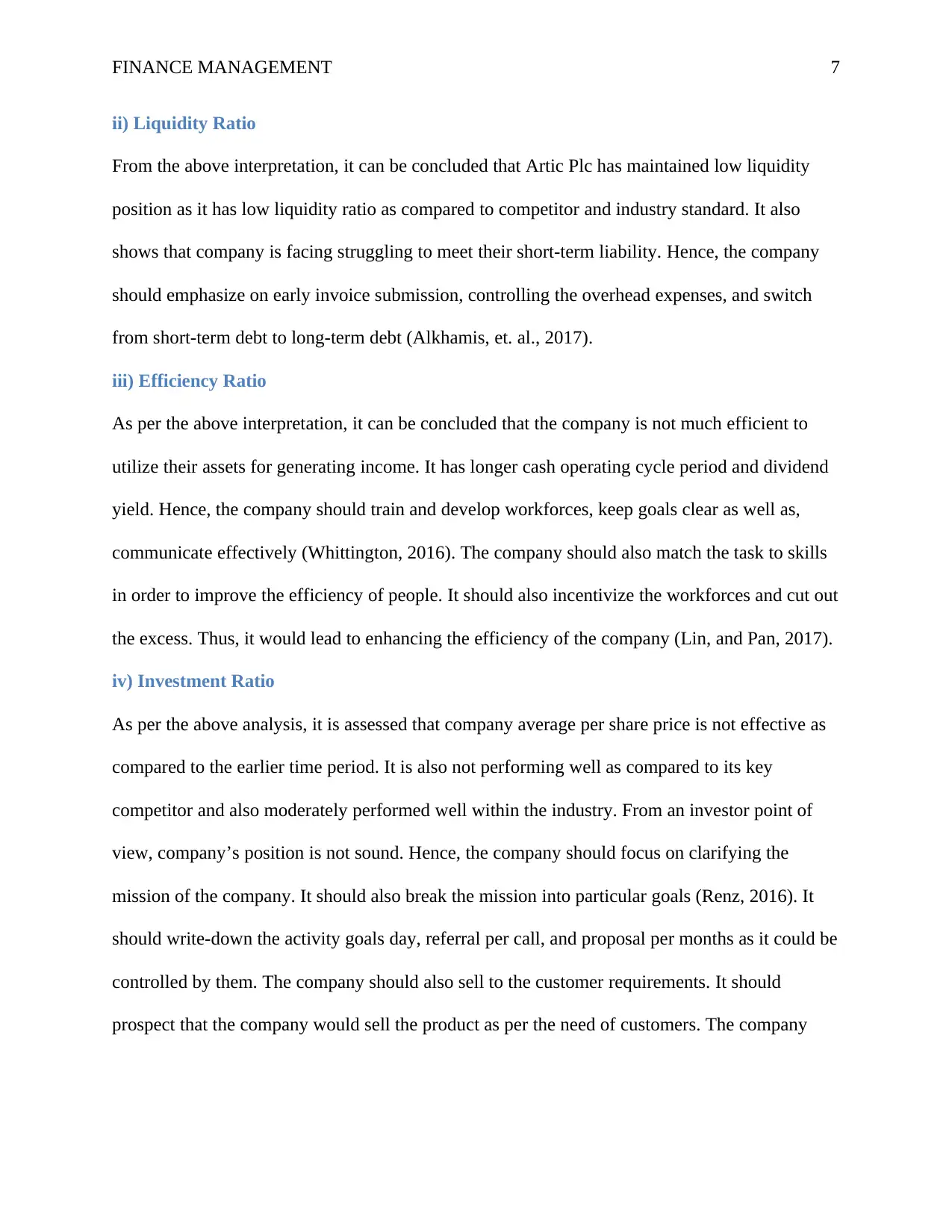
FINANCE MANAGEMENT 7
ii) Liquidity Ratio
From the above interpretation, it can be concluded that Artic Plc has maintained low liquidity
position as it has low liquidity ratio as compared to competitor and industry standard. It also
shows that company is facing struggling to meet their short-term liability. Hence, the company
should emphasize on early invoice submission, controlling the overhead expenses, and switch
from short-term debt to long-term debt (Alkhamis, et. al., 2017).
iii) Efficiency Ratio
As per the above interpretation, it can be concluded that the company is not much efficient to
utilize their assets for generating income. It has longer cash operating cycle period and dividend
yield. Hence, the company should train and develop workforces, keep goals clear as well as,
communicate effectively (Whittington, 2016). The company should also match the task to skills
in order to improve the efficiency of people. It should also incentivize the workforces and cut out
the excess. Thus, it would lead to enhancing the efficiency of the company (Lin, and Pan, 2017).
iv) Investment Ratio
As per the above analysis, it is assessed that company average per share price is not effective as
compared to the earlier time period. It is also not performing well as compared to its key
competitor and also moderately performed well within the industry. From an investor point of
view, company’s position is not sound. Hence, the company should focus on clarifying the
mission of the company. It should also break the mission into particular goals (Renz, 2016). It
should write-down the activity goals day, referral per call, and proposal per months as it could be
controlled by them. The company should also sell to the customer requirements. It should
prospect that the company would sell the product as per the need of customers. The company
ii) Liquidity Ratio
From the above interpretation, it can be concluded that Artic Plc has maintained low liquidity
position as it has low liquidity ratio as compared to competitor and industry standard. It also
shows that company is facing struggling to meet their short-term liability. Hence, the company
should emphasize on early invoice submission, controlling the overhead expenses, and switch
from short-term debt to long-term debt (Alkhamis, et. al., 2017).
iii) Efficiency Ratio
As per the above interpretation, it can be concluded that the company is not much efficient to
utilize their assets for generating income. It has longer cash operating cycle period and dividend
yield. Hence, the company should train and develop workforces, keep goals clear as well as,
communicate effectively (Whittington, 2016). The company should also match the task to skills
in order to improve the efficiency of people. It should also incentivize the workforces and cut out
the excess. Thus, it would lead to enhancing the efficiency of the company (Lin, and Pan, 2017).
iv) Investment Ratio
As per the above analysis, it is assessed that company average per share price is not effective as
compared to the earlier time period. It is also not performing well as compared to its key
competitor and also moderately performed well within the industry. From an investor point of
view, company’s position is not sound. Hence, the company should focus on clarifying the
mission of the company. It should also break the mission into particular goals (Renz, 2016). It
should write-down the activity goals day, referral per call, and proposal per months as it could be
controlled by them. The company should also sell to the customer requirements. It should
prospect that the company would sell the product as per the need of customers. The company
Paraphrase This Document
Need a fresh take? Get an instant paraphrase of this document with our AI Paraphraser
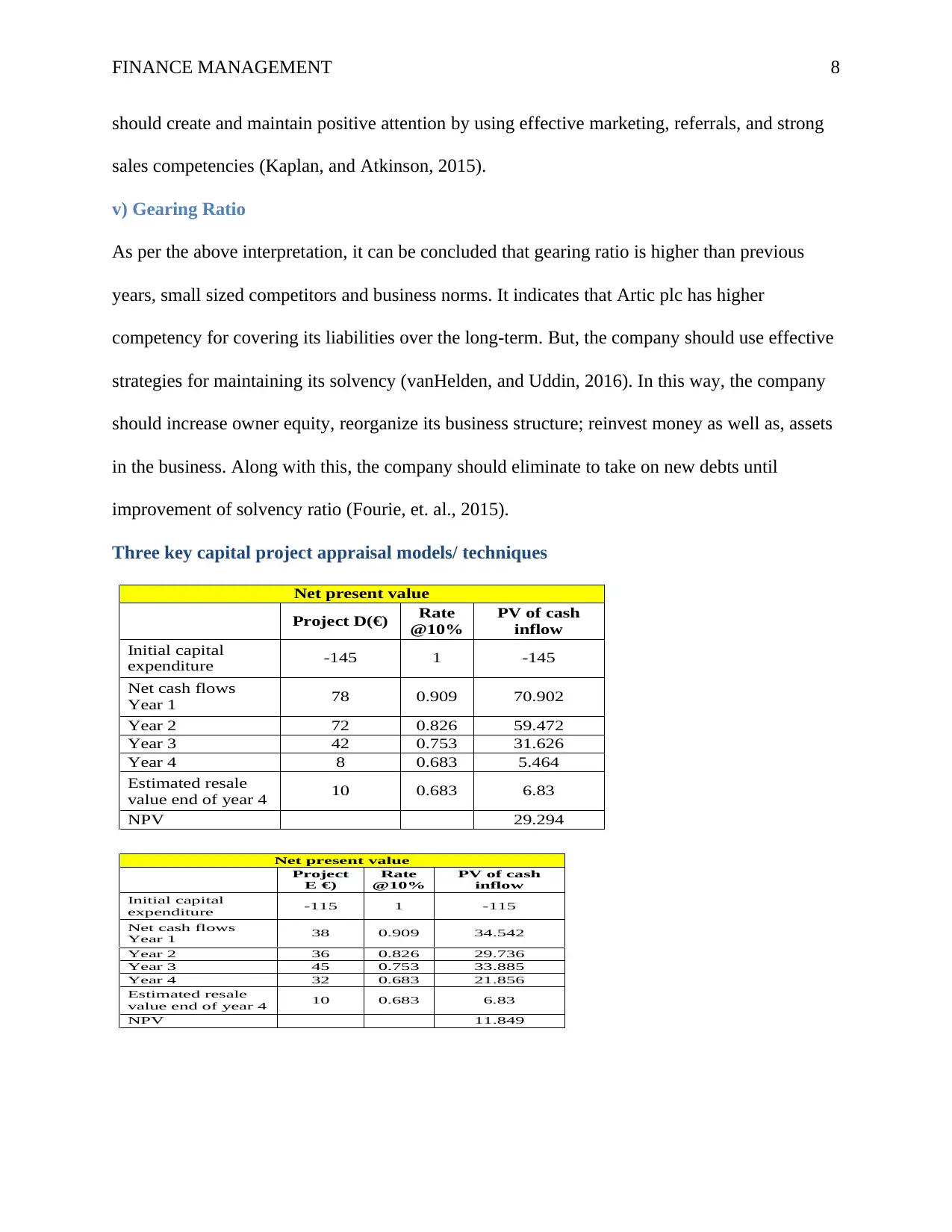
FINANCE MANAGEMENT 8
should create and maintain positive attention by using effective marketing, referrals, and strong
sales competencies (Kaplan, and Atkinson, 2015).
v) Gearing Ratio
As per the above interpretation, it can be concluded that gearing ratio is higher than previous
years, small sized competitors and business norms. It indicates that Artic plc has higher
competency for covering its liabilities over the long-term. But, the company should use effective
strategies for maintaining its solvency (vanHelden, and Uddin, 2016). In this way, the company
should increase owner equity, reorganize its business structure; reinvest money as well as, assets
in the business. Along with this, the company should eliminate to take on new debts until
improvement of solvency ratio (Fourie, et. al., 2015).
Three key capital project appraisal models/ techniques
Net present value
Project D(€) Rate
@10%
PV of cash
inflow
Initial capital
expenditure -145 1 -145
Net cash flows
Year 1 78 0.909 70.902
Year 2 72 0.826 59.472
Year 3 42 0.753 31.626
Year 4 8 0.683 5.464
Estimated resale
value end of year 4 10 0.683 6.83
NPV 29.294
Net present value
Project
E €)
Rate
@10%
PV of cash
inflow
Initial capital
expenditure -115 1 -115
Net cash flows
Year 1 38 0.909 34.542
Year 2 36 0.826 29.736
Year 3 45 0.753 33.885
Year 4 32 0.683 21.856
Estimated resale
value end of year 4 10 0.683 6.83
NPV 11.849
should create and maintain positive attention by using effective marketing, referrals, and strong
sales competencies (Kaplan, and Atkinson, 2015).
v) Gearing Ratio
As per the above interpretation, it can be concluded that gearing ratio is higher than previous
years, small sized competitors and business norms. It indicates that Artic plc has higher
competency for covering its liabilities over the long-term. But, the company should use effective
strategies for maintaining its solvency (vanHelden, and Uddin, 2016). In this way, the company
should increase owner equity, reorganize its business structure; reinvest money as well as, assets
in the business. Along with this, the company should eliminate to take on new debts until
improvement of solvency ratio (Fourie, et. al., 2015).
Three key capital project appraisal models/ techniques
Net present value
Project D(€) Rate
@10%
PV of cash
inflow
Initial capital
expenditure -145 1 -145
Net cash flows
Year 1 78 0.909 70.902
Year 2 72 0.826 59.472
Year 3 42 0.753 31.626
Year 4 8 0.683 5.464
Estimated resale
value end of year 4 10 0.683 6.83
NPV 29.294
Net present value
Project
E €)
Rate
@10%
PV of cash
inflow
Initial capital
expenditure -115 1 -115
Net cash flows
Year 1 38 0.909 34.542
Year 2 36 0.826 29.736
Year 3 45 0.753 33.885
Year 4 32 0.683 21.856
Estimated resale
value end of year 4 10 0.683 6.83
NPV 11.849
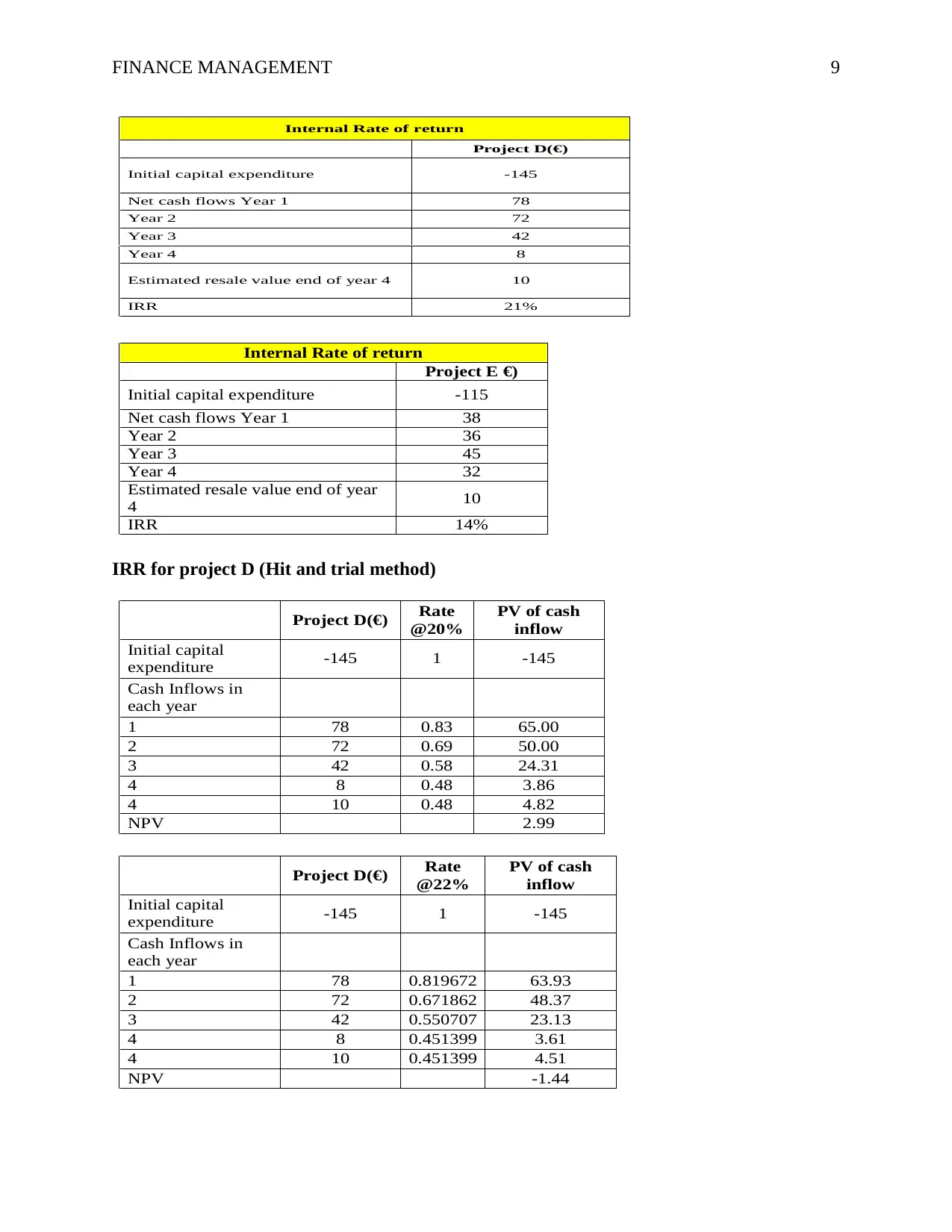
FINANCE MANAGEMENT 9
Internal Rate of return
Project D(€)
Initial capital expenditure -145
Net cash flows Year 1 78
Year 2 72
Year 3 42
Year 4 8
Estimated resale value end of year 4 10
IRR 21%
Internal Rate of return
Project E €)
Initial capital expenditure -115
Net cash flows Year 1 38
Year 2 36
Year 3 45
Year 4 32
Estimated resale value end of year
4 10
IRR 14%
IRR for project D (Hit and trial method)
Project D(€) Rate
@20%
PV of cash
inflow
Initial capital
expenditure -145 1 -145
Cash Inflows in
each year
1 78 0.83 65.00
2 72 0.69 50.00
3 42 0.58 24.31
4 8 0.48 3.86
4 10 0.48 4.82
NPV 2.99
Project D(€) Rate
@22%
PV of cash
inflow
Initial capital
expenditure -145 1 -145
Cash Inflows in
each year
1 78 0.819672 63.93
2 72 0.671862 48.37
3 42 0.550707 23.13
4 8 0.451399 3.61
4 10 0.451399 4.51
NPV -1.44
Internal Rate of return
Project D(€)
Initial capital expenditure -145
Net cash flows Year 1 78
Year 2 72
Year 3 42
Year 4 8
Estimated resale value end of year 4 10
IRR 21%
Internal Rate of return
Project E €)
Initial capital expenditure -115
Net cash flows Year 1 38
Year 2 36
Year 3 45
Year 4 32
Estimated resale value end of year
4 10
IRR 14%
IRR for project D (Hit and trial method)
Project D(€) Rate
@20%
PV of cash
inflow
Initial capital
expenditure -145 1 -145
Cash Inflows in
each year
1 78 0.83 65.00
2 72 0.69 50.00
3 42 0.58 24.31
4 8 0.48 3.86
4 10 0.48 4.82
NPV 2.99
Project D(€) Rate
@22%
PV of cash
inflow
Initial capital
expenditure -145 1 -145
Cash Inflows in
each year
1 78 0.819672 63.93
2 72 0.671862 48.37
3 42 0.550707 23.13
4 8 0.451399 3.61
4 10 0.451399 4.51
NPV -1.44
⊘ This is a preview!⊘
Do you want full access?
Subscribe today to unlock all pages.

Trusted by 1+ million students worldwide
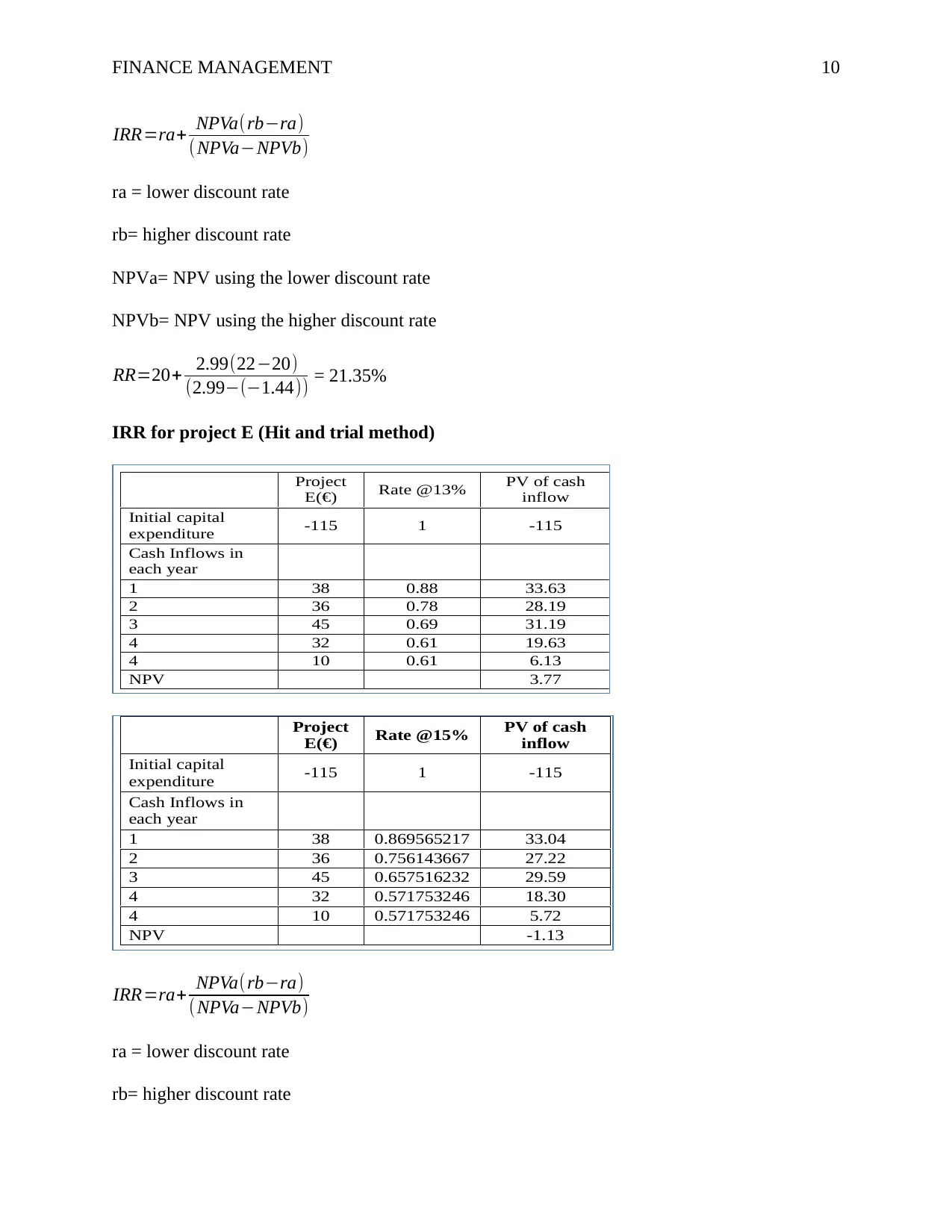
FINANCE MANAGEMENT 10
IRR=ra+ NPVa(rb−ra)
(NPVa−NPVb)
ra = lower discount rate
rb= higher discount rate
NPVa= NPV using the lower discount rate
NPVb= NPV using the higher discount rate
RR=20+ 2.99(22−20)
(2.99−(−1.44)) = 21.35%
IRR for project E (Hit and trial method)
Project
E(€) Rate @13% PV of cash
inflow
Initial capital
expenditure -115 1 -115
Cash Inflows in
each year
1 38 0.88 33.63
2 36 0.78 28.19
3 45 0.69 31.19
4 32 0.61 19.63
4 10 0.61 6.13
NPV 3.77
Project
E(€) Rate @15% PV of cash
inflow
Initial capital
expenditure -115 1 -115
Cash Inflows in
each year
1 38 0.869565217 33.04
2 36 0.756143667 27.22
3 45 0.657516232 29.59
4 32 0.571753246 18.30
4 10 0.571753246 5.72
NPV -1.13
IRR=ra+ NPVa(rb−ra)
(NPVa−NPVb)
ra = lower discount rate
rb= higher discount rate
IRR=ra+ NPVa(rb−ra)
(NPVa−NPVb)
ra = lower discount rate
rb= higher discount rate
NPVa= NPV using the lower discount rate
NPVb= NPV using the higher discount rate
RR=20+ 2.99(22−20)
(2.99−(−1.44)) = 21.35%
IRR for project E (Hit and trial method)
Project
E(€) Rate @13% PV of cash
inflow
Initial capital
expenditure -115 1 -115
Cash Inflows in
each year
1 38 0.88 33.63
2 36 0.78 28.19
3 45 0.69 31.19
4 32 0.61 19.63
4 10 0.61 6.13
NPV 3.77
Project
E(€) Rate @15% PV of cash
inflow
Initial capital
expenditure -115 1 -115
Cash Inflows in
each year
1 38 0.869565217 33.04
2 36 0.756143667 27.22
3 45 0.657516232 29.59
4 32 0.571753246 18.30
4 10 0.571753246 5.72
NPV -1.13
IRR=ra+ NPVa(rb−ra)
(NPVa−NPVb)
ra = lower discount rate
rb= higher discount rate
Paraphrase This Document
Need a fresh take? Get an instant paraphrase of this document with our AI Paraphraser
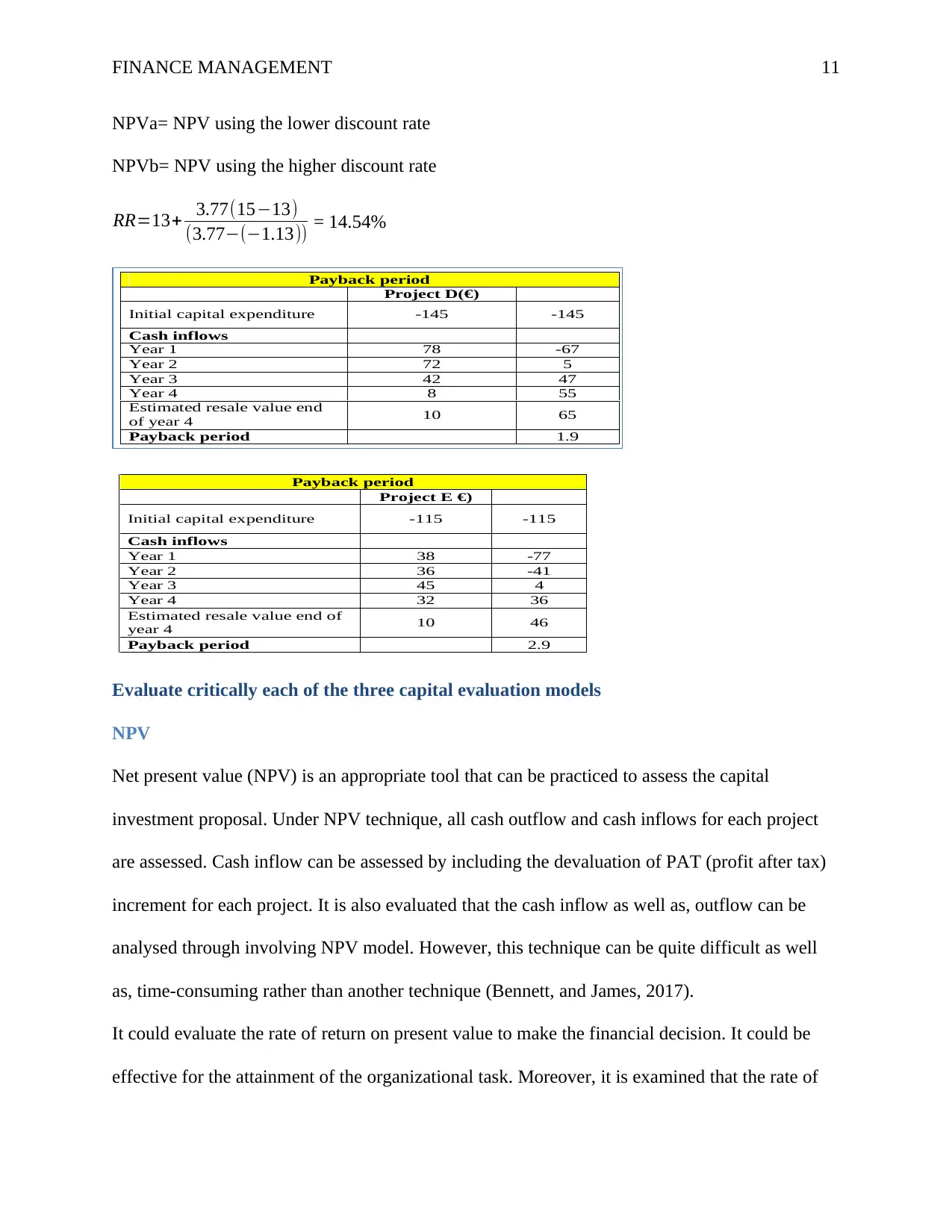
FINANCE MANAGEMENT 11
NPVa= NPV using the lower discount rate
NPVb= NPV using the higher discount rate
RR=13+ 3.77(15−13)
(3.77−(−1.13)) = 14.54%
Payback period
Project D(€)
Initial capital expenditure -145 -145
Cash inflows
Year 1 78 -67
Year 2 72 5
Year 3 42 47
Year 4 8 55
Estimated resale value end
of year 4 10 65
Payback period 1.9
Payback period
Project E €)
Initial capital expenditure -115 -115
Cash inflows
Year 1 38 -77
Year 2 36 -41
Year 3 45 4
Year 4 32 36
Estimated resale value end of
year 4 10 46
Payback period 2.9
Evaluate critically each of the three capital evaluation models
NPV
Net present value (NPV) is an appropriate tool that can be practiced to assess the capital
investment proposal. Under NPV technique, all cash outflow and cash inflows for each project
are assessed. Cash inflow can be assessed by including the devaluation of PAT (profit after tax)
increment for each project. It is also evaluated that the cash inflow as well as, outflow can be
analysed through involving NPV model. However, this technique can be quite difficult as well
as, time-consuming rather than another technique (Bennett, and James, 2017).
It could evaluate the rate of return on present value to make the financial decision. It could be
effective for the attainment of the organizational task. Moreover, it is examined that the rate of
NPVa= NPV using the lower discount rate
NPVb= NPV using the higher discount rate
RR=13+ 3.77(15−13)
(3.77−(−1.13)) = 14.54%
Payback period
Project D(€)
Initial capital expenditure -145 -145
Cash inflows
Year 1 78 -67
Year 2 72 5
Year 3 42 47
Year 4 8 55
Estimated resale value end
of year 4 10 65
Payback period 1.9
Payback period
Project E €)
Initial capital expenditure -115 -115
Cash inflows
Year 1 38 -77
Year 2 36 -41
Year 3 45 4
Year 4 32 36
Estimated resale value end of
year 4 10 46
Payback period 2.9
Evaluate critically each of the three capital evaluation models
NPV
Net present value (NPV) is an appropriate tool that can be practiced to assess the capital
investment proposal. Under NPV technique, all cash outflow and cash inflows for each project
are assessed. Cash inflow can be assessed by including the devaluation of PAT (profit after tax)
increment for each project. It is also evaluated that the cash inflow as well as, outflow can be
analysed through involving NPV model. However, this technique can be quite difficult as well
as, time-consuming rather than another technique (Bennett, and James, 2017).
It could evaluate the rate of return on present value to make the financial decision. It could be
effective for the attainment of the organizational task. Moreover, it is examined that the rate of
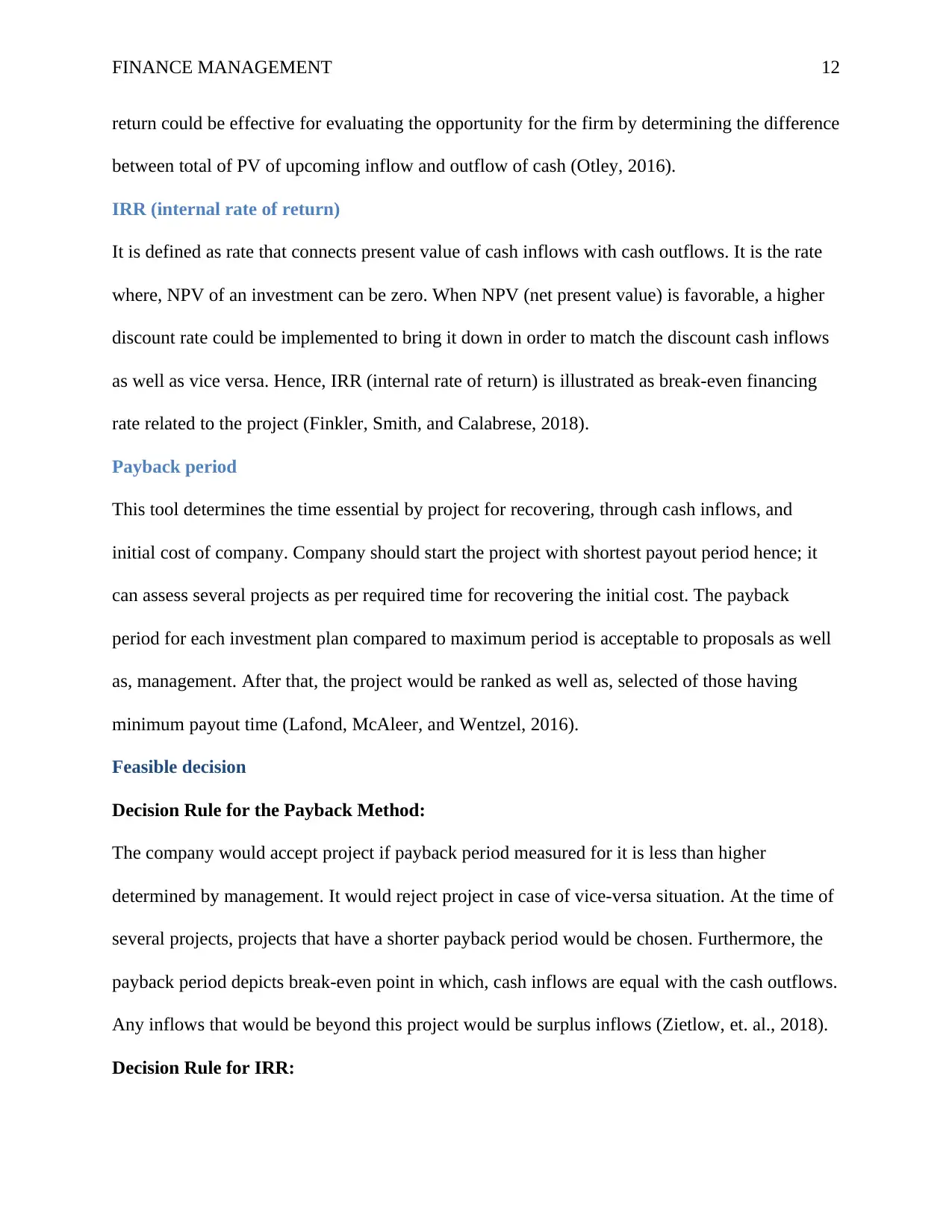
FINANCE MANAGEMENT 12
return could be effective for evaluating the opportunity for the firm by determining the difference
between total of PV of upcoming inflow and outflow of cash (Otley, 2016).
IRR (internal rate of return)
It is defined as rate that connects present value of cash inflows with cash outflows. It is the rate
where, NPV of an investment can be zero. When NPV (net present value) is favorable, a higher
discount rate could be implemented to bring it down in order to match the discount cash inflows
as well as vice versa. Hence, IRR (internal rate of return) is illustrated as break-even financing
rate related to the project (Finkler, Smith, and Calabrese, 2018).
Payback period
This tool determines the time essential by project for recovering, through cash inflows, and
initial cost of company. Company should start the project with shortest payout period hence; it
can assess several projects as per required time for recovering the initial cost. The payback
period for each investment plan compared to maximum period is acceptable to proposals as well
as, management. After that, the project would be ranked as well as, selected of those having
minimum payout time (Lafond, McAleer, and Wentzel, 2016).
Feasible decision
Decision Rule for the Payback Method:
The company would accept project if payback period measured for it is less than higher
determined by management. It would reject project in case of vice-versa situation. At the time of
several projects, projects that have a shorter payback period would be chosen. Furthermore, the
payback period depicts break-even point in which, cash inflows are equal with the cash outflows.
Any inflows that would be beyond this project would be surplus inflows (Zietlow, et. al., 2018).
Decision Rule for IRR:
return could be effective for evaluating the opportunity for the firm by determining the difference
between total of PV of upcoming inflow and outflow of cash (Otley, 2016).
IRR (internal rate of return)
It is defined as rate that connects present value of cash inflows with cash outflows. It is the rate
where, NPV of an investment can be zero. When NPV (net present value) is favorable, a higher
discount rate could be implemented to bring it down in order to match the discount cash inflows
as well as vice versa. Hence, IRR (internal rate of return) is illustrated as break-even financing
rate related to the project (Finkler, Smith, and Calabrese, 2018).
Payback period
This tool determines the time essential by project for recovering, through cash inflows, and
initial cost of company. Company should start the project with shortest payout period hence; it
can assess several projects as per required time for recovering the initial cost. The payback
period for each investment plan compared to maximum period is acceptable to proposals as well
as, management. After that, the project would be ranked as well as, selected of those having
minimum payout time (Lafond, McAleer, and Wentzel, 2016).
Feasible decision
Decision Rule for the Payback Method:
The company would accept project if payback period measured for it is less than higher
determined by management. It would reject project in case of vice-versa situation. At the time of
several projects, projects that have a shorter payback period would be chosen. Furthermore, the
payback period depicts break-even point in which, cash inflows are equal with the cash outflows.
Any inflows that would be beyond this project would be surplus inflows (Zietlow, et. al., 2018).
Decision Rule for IRR:
⊘ This is a preview!⊘
Do you want full access?
Subscribe today to unlock all pages.

Trusted by 1+ million students worldwide
1 out of 27
Related Documents
Your All-in-One AI-Powered Toolkit for Academic Success.
+13062052269
info@desklib.com
Available 24*7 on WhatsApp / Email
![[object Object]](/_next/static/media/star-bottom.7253800d.svg)
Unlock your academic potential
Copyright © 2020–2025 A2Z Services. All Rights Reserved. Developed and managed by ZUCOL.




